MBINGU VILLAGE, MOROGORO REGION, TANZANIA


Kokoa Kamili Fermentery was founded by Brian LoBue and Simran Bindra, who have backgrounds in international development throughout eastern and southern Africa. Prior to Kokoa Kamili’s Cooperative a single buyer dominated the area – the local arm of one of the world’s largest soft commodity trading houses. A sole buyer meant it had the power to set the price for cocoa, and farmers had little alternatives. Historically, farmers in the Kilombero Valley received some of the lowest prices for cocoa in the country. In Kokoa Kamili’s first year alone Kilombero farmers received the highest prices in Tanzania for their cocoa. Today, Kokoa Kamili works with nearly 3000 smallholder farmers, most of whom farm between 0.5 - 2 acres of cocoa. Kokoa Kamili pays a premium – well above the market rate -- to farmers for their ‘wet’ cocoa, and conducts its own fermentation and drying. By taking over the fermentation and drying process, Kokoa Kamili can consistently produce more higher quality cocoa beans. This method gives farmers a reduced workload, along with greater compensation, and the farmers are paid immediately after the cooperative receives its wet beans.
Kokoa Kamili also distributes cocoa seedlings to farmers in the community. In the past three years, they have aided in the planting of over 140,000 trees. Kokoa Kamili is situated in the Udzungwa Mountains National Park, an area known for its abundance of bird and mammal wildlife. It is most famous for the eleven different primate species, bird life, and is one of three remaining sites that support Savannah Elephants in a mountainous environment. Current estimates say that 2,000 elephants reside in and around the Udzungwa area.
TASTING NOTES:
Cherry, Coffee, Lemon
CAJAMARCA, PERU

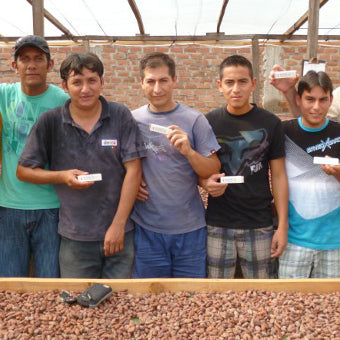

Riding a motorcycle through the jungles of Southern Cajamarca, Peru with a brass knuckle dagger in one hand and a pocket full of cash to pay the cocoa farmers is about as direct trade as you can get. It is no picnic getting beans from remote canyons that feed the Amazon but we did! I went to Peru last June and we are finally able to offer the bounty!
Our Cajamarca bar may be the best chocolate we have made. The terroir represented is that of a secluded canyon where the Pure National variety grows at a higher altitude than cacao is supposed to grow. The years of undisturbed, undiluted agriculture has manifested itself in a cacao that has a unique flavor profile and a silky texture that is about as good as it gets.
These storied beans have been made into chocolate before but only in Europe. We are among a small number of American craft chocolate makers who are privileged to work with them as our stock is from the first shipment of these beans to the US for production. I think we did the farmers justice as our chocolate attempts to showcase the hard source side work in the flavor profile. The ease at which this chocolate melts on your tongue is in complete contrast with the gargantuan journey this cacao endured to get to that point. I hope you agree!
TASTING NOTES:
The toasty caramel notes on the front end brighten up the darkest of days while the soft tannins offered by the white beans found in the pods, gently reign in the flavors with the loving authority of a mama goose. This is not a wild free-for-all explosion of flavor but a sophisticated, humorous assemblage of light, dancing acids, vanilla and caramel.
BALAO, ECUADOR
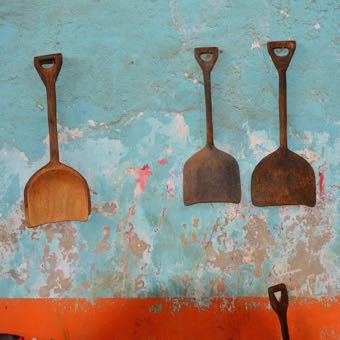
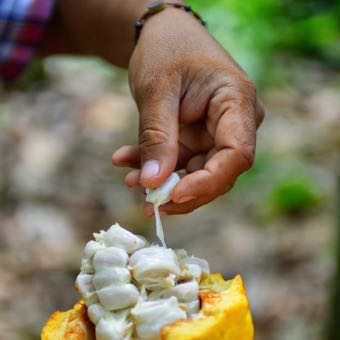

I have gone to visit several cacao farmers but I have only ever had one come to Portland to visit me! Vicente Norero, who runs Camino Verde in Baloa, Ecuador is one of the guys who is really pushing source side efforts to a new level. He has been working on his fermentation technique using practices common in wine making but nonexistent in cacao … until now. I almost had it, too! We were at a bar in Portland together after a few rounds, and he got a mad genius twinkle in his eye. He started to explain his secret technique to me in a heavy accent and good but not great English. I was nodding and smiling with crooked eyes as he asked the bartender for a paper and a pen. I knew I wasn't going to be able to retain any info from what he was saying so I was hatching a plan to pocket the document he was drafting. It looked like a cross between a hieroglyph, a ransom note and a math problem. When he finally finished, he looked up at me like a wolf that just had his first bite of something real good. Something he had just hunted down and killed. Vicente, practically drooling, tore the paper into little bits and dropped it in the trash behind the bar. That is specific as I can get about his technique. The chocolate will fill in the details.
The Ecuadorian cacao represents some of the most forward thinking growers and source side processors. Source side processing includes harvesting, fermenting and drying. Because cacao has not ever really had the attention given to it, at an artisenal level, fermentation and drying techniques did not matter as much as speed. Because large chocolate producers are driven more by consistency in flavor, they tend to stomp most of the flavor out of the cacao and manufacture a flavor using a variety of ingredients that you would never find in Nanna's cupboard. There was no reason to waste time experimenting with fermentation.
Enter Vicente! Like a winemaker, he stops the fermentation and kicks off a more controlled fermentation. His vision is large!
TASTING NOTES:
If chocolate were music, this chocolate would be solid baseline. The hue is almost aubergine, making it the darkest colored chocolate we make. The flavors are concentrated and extra big because of the low butter content in these beans. The chocolate is thick and dark and beautiful with a floral canopy that carries the whole symphony of flavor, the way a million balloons carry a field of wild flowers. Notes of cinnamon.
SAMBIRANO VALLEY, MADAGASCAR
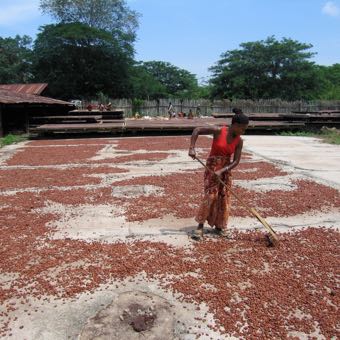
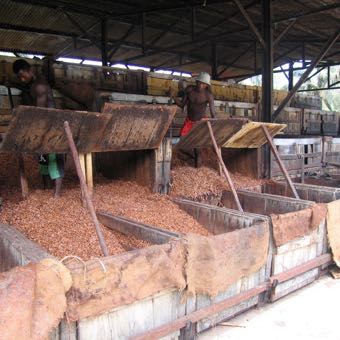

Akesson's Organic Estate, in the lower Sambirano Valley, grows cocoa and other tropical crops (Ylang Ylang, Peppercorns, coffee, Combava, Vetiver, Vanilla, rice, etc…) over 2000ha. It was planted in 1920 as part of a larger colonial plantation of 50.000ha that has since then been divided.
TASTING NOTES:
This chocolate is acidic and bright with identifiable raisin and dried cherry notes.
